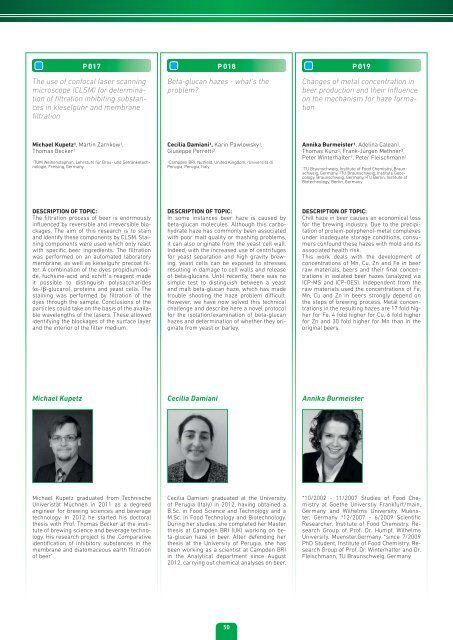please click here for download. - the 34th European Brewery ...
please click here for download. - the 34th European Brewery ...
please click here for download. - the 34th European Brewery ...
You also want an ePaper? Increase the reach of your titles
YUMPU automatically turns print PDFs into web optimized ePapers that Google loves.
P 017<br />
The use of confocal laser scanning<br />
microscope (CLSM) <strong>for</strong> determination<br />
of filtration inhibiting substances<br />
in kieselguhr and membrane<br />
filtration<br />
P 018<br />
Beta-glucan hazes - what‘s <strong>the</strong><br />
problem?<br />
P 019<br />
Changes of metal concentration in<br />
beer production and <strong>the</strong>ir Influence<br />
on <strong>the</strong> mechanism <strong>for</strong> haze <strong>for</strong>mation<br />
Michael Kupetz 1 , Martin Zarnkow 1 ,<br />
Thomas Becker 1<br />
1TUM Weihenstephan, Lehrstuhl für Brau- und Getränketechnologie,<br />
Freising, Germany<br />
Cecilia Damiani 1 , Karin Pawlowsky 1 ,<br />
Giuseppe Perretti 2<br />
1Campden BRI, Nutfield, United Kingdom, 2 Università di<br />
Perugia, Perugia, Italy<br />
Annika Burmeister 1 , Adelina Calean 2 ,<br />
Thomas Kunz 3 , Frank-Jürgen Methner 3 ,<br />
Peter Winterhalter 1 , Peter Fleischmann 1<br />
1TU Braunschweig, Institute of Food Chemistry, Braunschweig,<br />
Germany, 2 TU Braunschweig, Institute Geoecology,<br />
Braunschweig, Germany, 3 TU Berlin, Institute of<br />
Biotechnology, Berlin, Germany<br />
DESCRIPTION OF TOPIC:<br />
The filtration process of beer is enormously<br />
influenced by reversible and irreversible blockages.<br />
The aim of this research is to stain<br />
and identify <strong>the</strong>se components by CLSM. Staining<br />
components were used which only react<br />
with specific beer ingredients. The filtration<br />
was per<strong>for</strong>med on an automated laboratory<br />
membrane, as well as kieselguhr precoat filter.<br />
A combination of <strong>the</strong> dyes propidiumiodide,<br />
fuchsine-acid and schiff´s reagent made<br />
it possible to distinguish polysaccharides<br />
(α-/β-glucans), proteins and yeast cells. The<br />
staining was per<strong>for</strong>med by filtration of <strong>the</strong><br />
dyes through <strong>the</strong> sample. Conclusions of <strong>the</strong><br />
particles could take on <strong>the</strong> basis of <strong>the</strong> available<br />
wavelengths of <strong>the</strong> lasers. These allowed<br />
identifying <strong>the</strong> blockages of <strong>the</strong> surface layer<br />
and <strong>the</strong> interior of <strong>the</strong> filter medium.<br />
DESCRIPTION OF TOPIC:<br />
In some instances beer haze is caused by<br />
beta-glucan molecules. Although this carbohydrate<br />
haze has commonly been associated<br />
with poor malt quality or mashing problems,<br />
it can also originate from <strong>the</strong> yeast cell wall.<br />
Indeed, with <strong>the</strong> increased use of centrifuges<br />
<strong>for</strong> yeast separation and high gravity brewing,<br />
yeast cells can be exposed to stresses<br />
resulting in damage to cell walls and release<br />
of beta-glucans. Until recently, t<strong>here</strong> was no<br />
simple test to distinguish between a yeast<br />
and malt beta-glucan haze, which has made<br />
trouble shooting <strong>the</strong> haze problem difficult.<br />
However, we have now solved this technical<br />
challenge and describe <strong>here</strong> a novel protocol<br />
<strong>for</strong> <strong>the</strong> isolation/examination of beta-glucan<br />
hazes and determination of whe<strong>the</strong>r <strong>the</strong>y originate<br />
from yeast or barley.<br />
DESCRIPTION OF TOPIC:<br />
Chill haze in beer causes an economical loss<br />
<strong>for</strong> <strong>the</strong> brewing industry. Due to <strong>the</strong> precipitation<br />
of protein-polyphenol-metal complexes<br />
under inadequate storage conditions, consumers<br />
confound <strong>the</strong>se hazes with mold and its<br />
associated health risk.<br />
This work deals with <strong>the</strong> development of<br />
concentrations of Mn, Cu, Zn and Fe in beer<br />
raw materials, beers and <strong>the</strong>ir final concentrations<br />
in isolated beer hazes (analyzed via<br />
ICP-MS and ICP-OES). Independent from <strong>the</strong><br />
raw materials used <strong>the</strong> concentrations of Fe,<br />
Mn, Cu and Zn in beers strongly depend on<br />
<strong>the</strong> steps of brewing process. Metal concentrations<br />
in <strong>the</strong> resulting hazes are 17 fold higher<br />
<strong>for</strong> Fe, 4 fold higher <strong>for</strong> Cu, 6 fold higher<br />
<strong>for</strong> Zn and 30 fold higher <strong>for</strong> Mn than in <strong>the</strong><br />
original beers.<br />
Michael Kupetz<br />
Cecilia Damiani<br />
Annika Burmeister<br />
Michael Kupetz graduated from Technische<br />
Univeristät Müchnen in 2011 as a degreed<br />
engineer <strong>for</strong> brewing sciences and beverage<br />
technology. In 2012 he started his doctoral<br />
<strong>the</strong>sis with Prof. Thomas Becker at <strong>the</strong> institute<br />
of brewing science and beverage technology.<br />
His research project is <strong>the</strong> ‚Comparative<br />
identification of inhibitory substances in <strong>the</strong><br />
membrane and diatomaceous earth filtration<br />
of beer‘<br />
Cecilia Damiani graduated at <strong>the</strong> University<br />
of Perugia (Italy) in 2012, having obtained a<br />
B.Sc. in Food Science and Technology and a<br />
M.Sc. in Food Technology and Biotechnology.<br />
During her studies, she completed her Master<br />
<strong>the</strong>sis at Campden BRI (UK) working on beta-glucan<br />
haze in beer. After defending her<br />
<strong>the</strong>sis at <strong>the</strong> University of Perugia, she has<br />
been working as a scientist at Campden BRI<br />
in <strong>the</strong> Analytical department since August<br />
2012, carrying out chemical analyses on beer.<br />
*10/2002 - 11/2007 Studies of Food Chemistry<br />
at Goe<strong>the</strong> Universtiy Frankfurt/main,<br />
Germany and Wilhelms University, Muenster,<br />
Germany *12/2007 - 6/2009 Scientific<br />
Researcher, Institute of Food Chemistry, Research<br />
Group of Prof. Dr. Humpf, Wilhelms<br />
University, Muenster,Germany *since 7/2009<br />
PhD Student, Institute of Food Chemistry, Research<br />
Group of Prof. Dr. Winterhalter and Dr.<br />
Fleischmann, TU Braunschweig, Germany<br />
50





